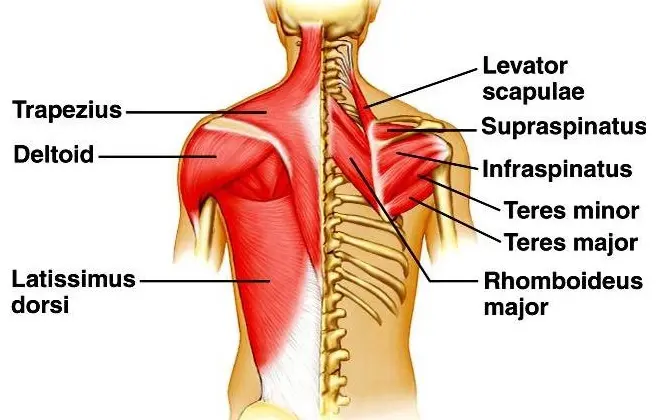When it comes to the lats, most lifters already know how to train them for size and strength. If you want a broader, more powerful upper back and impressive V-taper, moves like pull-ups, lat pulldowns, and rows should be the cornerstone of your workouts.
However, because of a phenomenon called adaptive shortening, if you train your lats hard, you also need to stretch them. For example, tight lats can have a detrimental effect on shoulder function, posture, and upper back aesthetics.
Lat tightness is common among strength trainers, but it doesn’t have to be. In fact, the lats are pretty straightforward to stretch, and you can easily give them the attention they deserve by stretching them between sets, at work, and at home.
In this article, we reveal how to stretch this crucial upper back muscle.
Latissimus Dorsi Anatomy
While you don’t need a degree in functional anatomy to stretch your latissimus dorsi or lats for short, it may be helpful to know a little more about this massive muscle so you can choose the best exercises.
Latissimus dorsi means side back muscle, which tells you (in Latin!) where your lats are. The lats basically connect your arms to your torso, and as such, they control several upper arm and shoulder movements.
Level Up Your Fitness: Join our 💪 strong community in Fitness Volt Newsletter. Get daily inspiration, expert-backed workouts, nutrition tips, the latest in strength sports, and the support you need to reach your goals. Subscribe for free!
Adduction of the shoulder joint – the lats adduct the shoulder joint, meaning they pull your upper arms down and into your sides, such as during lat pulldowns or wide-grip pull-ups. Adduction (to add) means to bring any limb in toward the midline of your body.
Tight lats make it harder to extend your arms above your head. For this reason, lifters with tight lats often struggle with shoulder presses and may have to lean back to raise their arms vertically. This restriction and the subsequent compensatory movement can lead to lower back pain.
Extension of the shoulder joint – as well as adducting your shoulder, the lats are also responsible for shoulder extension. This means drawing your upper arms backward. Exercises that involve this movement include seated and bent-over rows.
Medial rotation of the shoulder joint – medial or internal rotation means turning inward. The lats are a back muscle, but they attach to the front of your humerus. As such, when they contract, they turn your upper arms inward. Doing a front “lat spread” is an example of this movement.
Tight lats can cause your upper arms to turn inward. This may also be accompanied by protracted or hunched shoulders. Medially rotated shoulders are more prone to impingement and other shoulder injuries.
The 10 Best Lat Stretches
Whether you want to build a more muscular back, improve shoulder mobility, or develop better posture, these are the ten best lat stretching exercises!
1. Dead hang
The dead hang is often viewed as a grip-building exercise. However, it’s also an excellent lat stretch that simultaneously decompresses your spine. With this exercise, you use your bodyweight to lengthen your lats and extend/abduct your shoulders, so it’s a very time-efficient exercise.
Try doing brief dead hangs between sets of deadlifts, squats, and upper body pushing exercises to lengthen your lats and deload your spine.
How to do it:
- Find somewhere suitable to hang. You should be able to touch the bar without jumping. Use a step or a bench to ensure you can comfortably reach the bar. Also, ensure that your feet are clear of the floor once you are hanging from the bar.
- Hold the bar with an overhand, slightly wider than shoulder-width grip. Chalk your hands if your palms are sweaty. You can also use a hook grip.
- Using a narrower grip takes your lats though a wider range of motion, so try bringing your hands closer if you need a deeper stretch.
- With your arms straight, hang from the bar with your feet off the floor. Do not fully relax your shoulders. Instead, keep them active by pulling them slightly down and back. Do not hold your breath.
- Remain motionless – no swinging or twisting – for the duration of your set. When you are done, step rather than jump down as jumping will shock load your spine, negating some of the decompressing benefits of this exercise.
- You can increase the stretch on your lats by carefully allowing your shoulders to rise. However, you should still not completely relax your shoulders as doing so will put a lot of stress on the passive structures of your shoulder joints and could lead to injury.
2. Kneeling lat stretch
This exercise not only stretches your lats but also extends your thoracic or upper spine. Tight lats and an immobile thoracic spine are common in people who spend a lot of time sitting at a desk or driving. While this exercise is often done using an exercise bench, it can also be performed using a chair, making it ideal for office warriors.
How to do it:
- Kneel down in front of a chair or bench.
- Place your hands and forearms on the bench so your arms are straight.
- Gently lower your head down between your arms until you feel a stretch in your chest and upper back. Imagine you are trying to touch the floor with your chest, but take care NOT to hyperextend your lumbar spine.
- Hold this position for 30-60 seconds. Go a little deeper as you feel your muscles relax.
3. Single-arm lat stretch
It’s very common to have one lat tighter than the other. Very few people are perfectly symmetrical. This simple stretch provides an easy way to stretch each side of your lats independently. If you notice that one lat feels tighter than the other, either spend more time or do an extra set on that side. In time, balance will be restored.
How to do it:
Level Up Your Fitness: Join our 💪 strong community in Fitness Volt Newsletter. Get daily inspiration, expert-backed workouts, nutrition tips, the latest in strength sports, and the support you need to reach your goals. Subscribe for free!
- Lean forward and hold a sturdy waist-high post, such as a squat rack, fence, or railing. Your arm should be straight, lower back slightly arched, and knees unlocked. Your upper body and arm should be roughly parallel to the floor.
- Push your hips back to extend your shoulder and stretch your lats. Deepen the stretch by turning your hips away from your extended shoulder.
- Hold for 30-60 seconds, increasing the stretch as you feel your lats relax, and repeat on both sides.
4. Standing lat stretch
This exercise uses a wall to extend your arm overhead and provide a deep, passive stretch for your lats. This is a good option for during your cool-down, as it requires very little energy to perform. However, the wall means you can take your lats through an extensive range of motion, making it ideal for improving flexibility.
How to do it:
- Stand sideways onto a smooth wall. Extend your nearest arm above your head and place it against the wall. Reach up as high as is comfortable.
- Lean inward and use the wall to push your arm further upward and into deeper extension. Imagine you are trying to press your armpit against the wall.
- Do not force the movement, as doing so could lead to shoulder injury. Instead, ease into the muscle tension until you feel a mild stretch in the lats.
- Hold for 30-60 seconds, increasing the stretch as you feel your lats relax, and repeat on both sides.
5. Standing overhead lat stretch
The great thing about this exercise is that you can do it right now! Seated or standing, this convenient exercise provides an excellent way to stretch your lats anytime they start to feel a little tight. All you need is enough space to extend your arms overhead.
How to do it:
- Interlace your fingers in front of your hips and sit or stand in good posture.
- Raise your arms above your head, pressing your palms up toward the ceiling.
- Take care not to hyperextend your lumber spine. The movement should come mainly from your shoulders and thoracic spine.
- Hold for 30-60 seconds, increasing the stretch as you feel your lats relax.
6. Single arm overhead lat stretch
This is a unilateral or single-sided version of exercise #5. However, stretching one side at a time will allow you to lean to the side, taking the origin and insertion of the lats further apart for a deeper stretch. In addition, this exercise will stretch your obliques or waist muscles.
How to do it:
- Stand with your feet about shoulder-width apart or wider. Raise one arm above your head and keep the other arm down by your side.
- Reach your raised arm over your head and simultaneously slide your opposite arm down your leg until you feel a deep stretch in the lat below your extended arm.
- Hold for 30-60 seconds, increasing the stretch as you feel your lats relax, and repeat on both sides.
7. Bear hug lat stretch
This stretch works your lats, mid-traps, rhomboids, and posterior deltoids to provide total upper body relief of tightness and tension. It feels especially good after long periods of driving or hunching over a computer. You can do this exercise seated or standing as preferred.
How to do it:
- Sitting or standing in good posture, reach around your body to place your left hand on your right lat and your right hand on your left lat. Give yourself a big old hug!
- Spread your shoulder blades apart, and imagine you are trying to make your upper back as wide as you can.
- Hold for 30-60 seconds, increasing the stretch as you feel your upper back and lats relax.
8. Overhead supine lat stretch with dowel or barbell
The lats are a large, powerful muscle that are often very resistant to stretching. This exercise uses a light weight to stretch your lats passively. This is an excellent exercise for doing between sets of regular gym work and can be done using a wooden dowel, plastic pipe, or a lightly loaded barbell.
How to do it:
- Lie on an exercise bench with your legs bent and feet resting on the end. Hold your bar with an overhand, shoulder-width grip. Move your hands further apart if your lats are very tight. Press your lower back into the bench.
- Extend your arms and lower the bar down toward the floor. Keep your arms straight and lower back pressed into the bench.
- Hold for 30-60 seconds, increasing the stretch as you feel your lats relax.
9. Kneeling lat stretch
If you really want to lengthen your lats, you may benefit from some prolonged stretching. But, of course, to hold a stretch for more than a couple of minutes, you need to be comfortable so you can stay relaxed. Tension anywhere in your body will make your lat stretch less effective. This kneeling stretch is ideal for long holds and provides a great way to reduce stress and muscle tension.
How to do it:
- Kneel on the floor on all fours.
- Sink back onto your heels and extend your arms out in front of you. Lower your chest down toward the floor.
- Move your hands forward if you need a deeper stretch. You can also place your hands on a raised surface, such as yoga blocks.
- Hold this position for 2-5 minutes, moving a little deeper as you feel your muscles relax.
10. Foam rolling the lats
Your muscles are surrounded by a thin layer of fibrous tissue called fascia. Fascia separates and connects each muscle from its neighbor. This fascia can become “gummed up,” leading to tight, painful muscles. This can cause trigger points, poor blood flow, and reduced function.
Foam rolling is a form of self-massage called self-myofascial release that can help free up your fascia and restore normal movement and function. Foam rolling your lats will enhance shoulder joint mobility, posture, and performance.
How to do it:
- Lie on your side and place your foam roller under your armpit. Extend your arm overhead to lengthen your lats. Use your other arm for balance.
- Using your legs to move, roll slowly up and down your lats, seeking out any areas of tension or tenderness. Spend a little longer on them until they start to diminish.
- Continue for 2-4 minutes, and then swap sides.
Note: Foam rolling can be painful at first. But, as the adhesions and hot sports start to dissolve, subsequent foam rolling sessions should be less uncomfortable. Start light and increase the pressure gradually to avoid unnecessary pain.
More Stretches:
- Don’t Just Sit There! 8 Useful Things to Do Between Sets in The Gym
- Essential 6-Minute Stretching Sequence for Immediate Muscle Relief
- Partner-Assisted Stretching: Just Lazy or the Key to Optimizing Your Flexibility?
- Age-Proof Your Body: The Ultimate Guide to Exercises That Prevent Mobility and Muscle Loss
- Unlock Your Hip Flexors: Assisted Prone Lying Quads Stretch Guide
- 10 Best Abs Stretches to Improve Flexibility
- Say Goodbye to Stretching: Relieve Upper Body Tension with This 10-Minute Foam Rolling Routine
- How a 2-Minute Hanging Habit Transforms Your Body (Science Explained)
- 5 Life-Changing Stretches for People Who Sit All Day
- Don’t Skip the Cool Down! 20 Exercises for Better Recovery and Reduced Muscle Soreness
Lat Stretches – Wrapping Up
Lat tightness is very common. If, when you stand facing a mirror, your arms turn inward so you can see the backs of your hands in your reflection, the chances are good that you have tight lats.
Tight lats can have a significant impact on your posture and your ability to perform overhead lifts, such as the shoulder press. Lat tightness is also a leading cause of shoulder pain.
So, make sure you stretch your lats as well as size and strength. Use these lat exercises to prevent adaptive shortening and restore lat flexibility and shoulder mobility.









